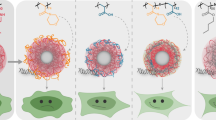Abstract
The clinical applications of cationic polymer-based non-viral gene carriers are usually hindered by the instability of polyplex or complex between these cationic polymers and anionic genes. In order to increase the stability, an amphiphilic cationic block copolymer PHB-b-PDMAEMA was designed to form cationic micelle, which comprised hydrophobic poly[(R)-3-hydroxybutyrate] (PHB) block and cationic poly(2-(dimethylamino)ethyl methacrylate) (DMAEMA) block. Interestingly, this cationic micelle after complex formation with plasmid deoxyribonucleic acid (pDNA) exhibited enhanced stability within 24 h and showed improved gene transfection performance than PDMAEMA only or non-viral transfection gold standard poly(ethylene imine) with molecular weight of 25 kDa (PEI-25k). In short, the design of cationic amphiphilic polymer, with micelle formation ability to enhance stability of polyplex, might greatly benefit the designs of non-viral cationic polymers as potential gene vectors.



Similar content being viewed by others
References
Xia JL, Chen J, Lin L, Guo ZP, Han B, Yang HY, Feng ZC, Tian HY (2016) Sulfathiazole grafted PEG–PLL as pH-sensitive shielding system for cationic gene delivery. Polym Bull 73(12):3503–3511
Badwaik VD, Aicart E, Mondjinou YA, Johnson MA, Bowman VD, Thompson DH (2016) Structure-property relationship for in vitro siRNA delivery performance of cationic 2-hydroxypropyl-beta-cyclodextrin: PEG–PPG–PEG polyrotaxane vectors. Biomaterials 84:86–98
Li Z, Liu X, Chen X, Chua MX, Wu Y-L (2017) Targeted delivery of Bcl-2 conversion gene by MPEG–PCL–PEI–FA cationic copolymer to combat therapeutic resistant cancer. Mater Sci Eng C 76:66–72
Liu X, Chen X, Chua MX, Li Z, Loh XJ, Wu Y-L (2017) Injectable supramolecular hydrogels as delivery agents of Bcl-2 conversion gene for the effective shrinkage of therapeutic resistance tumors. Adv Healthcare Mater 6(11):1700159
Wu Y-L, Engl W, Hu B, Cai P, Leow WR, Tan NS, Lim CT, Chen X (2017) Nanomechanically visualizing drug–cell interaction at the early stage of chemotherapy. ACS Nano 11(7):6996–7005
Cheng H, Wu Z, Wu C, Wang X, Liow SS, Li Z, Wu Y-L (2018) Overcoming STC2 mediated drug resistance through drug and gene co-delivery by PHB-PDMAEMA cationic polyester in liver cancer cells. Mater Sci Eng C 83:210–217
Liu X, Li Z, Loh XJ, Chen K, Li Z, Wu Y-L (2018) Targeted and sustained corelease of chemotherapeutics and gene by injectable supramolecular hydrogel for drug-resistant cancer therapy. Macromol Rapid Commun 39:1800117
Cheng H, Fan X, Wu C, Wang X, Wang L-J, Loh XJ, Li Z, Wu Y-L (2018) Cyclodextrin-based star-like amphiphilic cationic polymer as a potential pharmaceutical carrier in macrophages. Macromol Rapid Commun 39:1800207
Nishiyama N, Bae Y, Miyata K, Fukushima S, Kataoka K (2005) Smart polymeric micelles for gene and drug delivery. Drug Discov Today Technol 2(1):21–26
Wang Y, Ke CY, Weijie Beh C, Liu SQ, Goh SH, Yang YY (2007) The self-assembly of biodegradable cationic polymer micelles as vectors for gene transfection. Biomaterials 28(35):5358–5368
Xiang Y, Oo NNL, Lee JP, Li Z, Loh XJ (2017) Recent development of synthetic nonviral systems for sustained gene delivery. Drug Discov Today 22(9):1318–1335
Lu X, Jia F, Tan X, Wang D, Cao X, Zheng J, Zhang K (2016) Effective antisense gene regulation via noncationic, polyethylene glycol brushes. J Am Chem Soc 138(29):9097–9100
Fan X, Chung JY, Lim YX, Li Z, Loh XJ (2016) Review of adaptive programmable materials and their bioapplications. ACS Appl Mater Interfaces 8(49):33351–33370
Li Z, Loh XJ (2017) Recent advances of using polyhydroxyalkanoate-based nanovehicles as therapeutic delivery carriers. Wiley Interdiscip Rev Nanomed Nanobiotechnol 9(3):e1429
Fan XS, Li ZBA, Loh XJ (2016) Recent development of unimolecular micelles as functional materials and applications. Polym Chem 7(38):5898–5919
Li ZB, Wong SL (2017) Functionalization of 2D transition metal dichalcogenides for biomedical applications. Mat Sci Eng C Mater 70:1095–1106
Ding CZ, Li ZB (2017) A review of drug release mechanisms from nanocarrier systems. Mat Sci Eng C Mater 76:1440–1453
Zheng C, Gao H, Yang D-P, Liu M, Cheng H, Wu Y-L, Loh XJ (2017) PCL-based thermo-gelling polymers for in vivo delivery of chemotherapeutics to tumors. Mater Sci Eng C 74:110–116
Loh XJ, Ong SJ, Tung YT, Choo HT (2013) Co-delivery of drug and DNA from cationic dual-responsive micelles derived from poly (DMAEMA-co-PPGMA). Mater Sci Eng C Mater Biol Appl 33(8):4545–4550
Cheng H, Fan X, Wang X, Ye E, Loh XJ, Li Z, Wu Y-L (2018) Hierarchically self-assembled supramolecular host–guest delivery system for drug resistant cancer therapy. Biomacromolecules 19(6):1926–1938
Wang X, Liow SS, Wu Q, Li C, Owh C, Li Z, Loh XJ, Wu Y-L (2017) Codelivery for paclitaxel and Bcl-2 conversion gene by PHB-PDMAEMA amphiphilic cationic copolymer for effective drug resistant cancer therapy. Macromol Biosci 17(11):1700186
Loh XJ, Ong SJ, Tung YT, Teng CH (2013) Dual responsive micelles based on poly[(R)-3-hydroxybutyrate] and poly(2-(di-methylamino)ethyl methacrylate) for effective doxorubicin delivery. Polym Chem 4(8):2564–2574
Loh XJ, Ong SJ, Tung YT, Choo HT (2013) Incorporation of poly[(R)-3-hydroxybutyrate] into cationic copolymers based on poly(2-(dimethylamino)ethyl methacrylate) to improve gene delivery. Macromol Biosci 13(8):1092–1099
Funding
Funding was provided by Xiamen Science and Technology Program Grant (Grant No. 3502Z20174025), Fujian Health-Education Research Grant (Grant No. WKJ2016-2-03), and Fujian Provincial Natural Science Foundation (Grant No. 2015J01416).
Author information
Authors and Affiliations
Corresponding author
Rights and permissions
About this article
Cite this article
Zheng, Y., Wang, X., Qiu, F. et al. Amphiphilic polymer to improve polyplex stability for enhanced transfection efficiency. Polym. Bull. 76, 2471–2479 (2019). https://doi.org/10.1007/s00289-018-2506-8
Received:
Revised:
Accepted:
Published:
Issue Date:
DOI: https://doi.org/10.1007/s00289-018-2506-8




